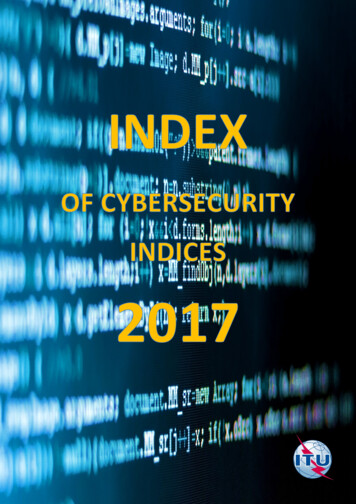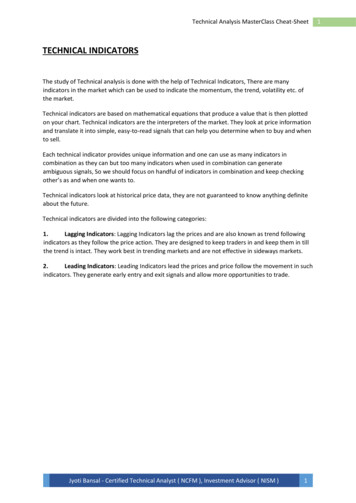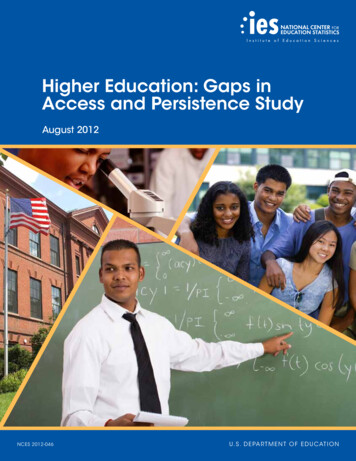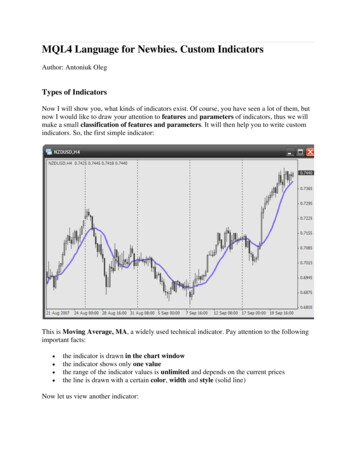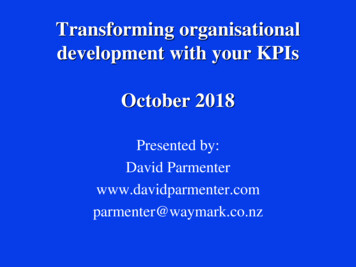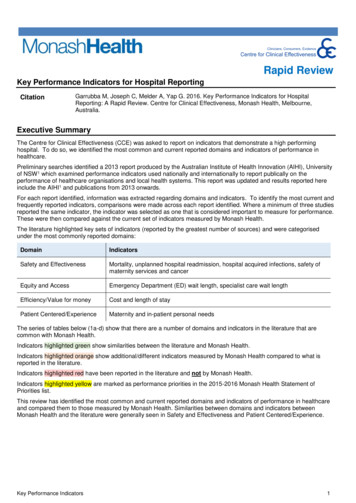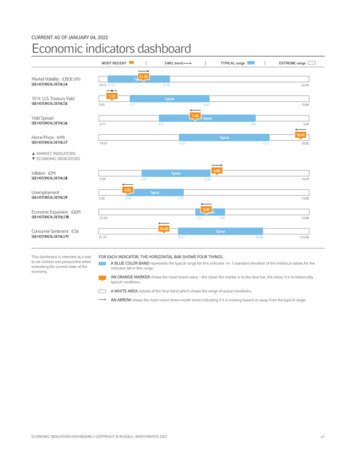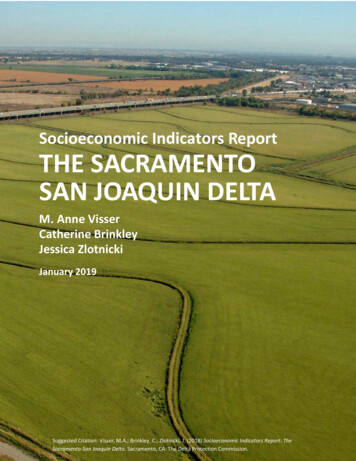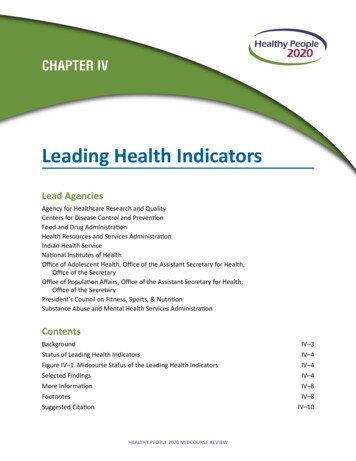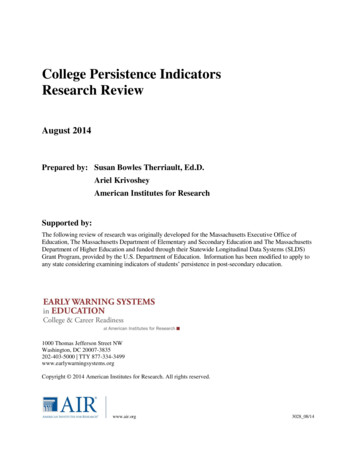
Transcription
College Persistence IndicatorsResearch ReviewAugust 2014Prepared by: Susan Bowles Therriault, Ed.D.Ariel KrivosheyAmerican Institutes for ResearchSupported by:The following review of research was originally developed for the Massachusetts Executive Office ofEducation, The Massachusetts Department of Elementary and Secondary Education and The MassachusettsDepartment of Higher Education and funded through their Statewide Longitudinal Data Systems (SLDS)Grant Program, provided by the U.S. Department of Education. Information has been modified to apply toany state considering examining indicators of students’ persistence in post-secondary education.1000 Thomas Jefferson Street NWWashington, DC 20007-3835202-403-5000 TTY 877-334-3499www.earlywarningsystems.orgCopyright 2014 American Institutes for Research. All rights reserved.www.air.org3028 08/14
ContentsPageIntroduction .1Findings.1Caveats and Considerations .2Student-Level Indicators .2Precollege Indicators .2College Indicators .4Academic Indicators .4Social Indicators.5Life Experience Indicators .6Institutional Factors .7State Persistence Indicators for Consideration .8Recommendations .15References .16
IntroductionThe following is a review of research on higher education persistence indicators. For thepurposes of this document, higher education persistence indicators are those indicators that canbe used to predict whether a student will stay in college and complete a two- or four-year degree.The review was originally conducted by researchers at the American Institutes for Research(AIR) for the Executive Office of Education, the Massachusetts Department of Elementary andSecondary Education (ESE), the Massachusetts Department of Higher Education (DHE), and theMassachusetts Department of Early Education and Care. The following has been modified to beapplicable to other states considering the collection and analysis of these types of indicators.The review of research was conducted through an extensive search of online databases andwebsites focused on research related to persistence indicators and college completion. Thedatabases and search engines used in the search were JSTOR, Education Resources InformationCenter (ERIC), and Google. In addition, AIR higher education experts were interviewed toidentify seminal research on the topic.FindingsResearch suggests that the underlying reasons for not completing a college degree are as variedas the numbers and types of students who attend college. Three decades of research focused onpersistence reveals that the topic is complex in that it represents a blending of individualpersonal, academic, and background characteristics with higher education institutions, as well asa transition between arguably structured educational experience (high school) to a wide range ofsettings, climates, and cultures that characterize colleges and universities. Still, there are earlysigns of risk that a student will not complete a degree. These signs or indicators may allow highschools and institutions of higher education to target supports to students while they are still inschool and well as to examine patterns over time. Tracking these indicators may enable highereducation institutions to meet accountability measures to improve degree completion rates.This review focuses on indicators that could be included as data elements within a statelongitudinal data system in terms of the practicality of data sources and burden of collection.Therefore, to the extent possible we have limited our presentation to those persistence indicatorsthat are prevalent in the literature, and then indicate when they are clear and measurable.The review primarily examined potential indicators of college persistence for individual studentsand also examined some indicators that are specifically related to characteristics of highereducation institutions. Accordingly, the findings are organized into student indicators andinstitutional indicators. The student indicators fall into three categories: precollege behavior,college behavior, and life experience. Finally, the last section discusses key considerations forstates interested in these types of indicators.American Institutes for ResearchCollege Persistence Indicators Research Review—1
Caveats and ConsiderationsResearch on persistence in college spans decades and reflects shifts in thinking about access tohigher education, as well as ideas about the demand and necessity of a college education. Theevolution in ideas about who and why students should complete a college degree, and theassumptions about the ways in which students access college, are different today from what theymay have been even a decade ago (e.g., the expectation that most students attending four-yearinstitutions reside on or near campus). Therefore, it is likely that there are new indicators ofpersistence that more accurately capture information about the students who enroll in college andthe ways in which the access college (e.g., taking online courses, attending part-time). Similarly,it is very possible that some indicators that are based on older research are no longer accuratepredictors of whether students persist in college or not.It is also important to note that the research on persistence in higher education tends to focus oncompletion of the first year (or even semester) of school, since that is the observable point atwhich a large number of students either continue in their studies or drop out of college. This hasimplications for how the research and this review are interpreted. First, the indicators identifiedmay be more accurate for predicting the probability of first-year completion than 2- or 4-yeardegree completion. Second, there may be additional or different indicators (e.g., creditaccumulation, level of courses taken) that are more predictive of college completion as a studentprogresses from year to year.The indicators presented in this review represent possible indicators for consideration. Stateleaders and policymakers need ensure attention to the level of burden for collecting student-leveldata and defining indicators is paid, as the burden for some may prove to be too great (e.g.,student-faculty interaction).Student-Level IndicatorsStudent-level persistence indicators are related to students’ background characteristics, preparationfor college, college experience, and life experience. Together these represent a complex set offactors that affect students’ ability to persist in college. The following section focuses on studentlevel indicators and have been organized into three broad categories: (1) precollege indicators, (2)college indicators (academic and social), and (3) life experience-related indicators.Precollege IndicatorsPrecollege indicators are based on student data obtained before the student enters college andthat are predictive of whether a student will persist in college. Precollege indicators are based oninformation prior to a student entering college. Therefore, these indicators may be used toidentify students who may benefit from support while they are still in high school that couldpotentially improve their likelihood of persisting in college.1 Often referred to as “collegereadiness,” precollege indicators tend to focus on the level of preparation a high school studentneeds to succeed, without remediation, in a core, credit-level course of study at a postsecondary1Precollege indicators may be used as part of the selection criteria for some colleges.American Institutes for ResearchCollege Persistence Indicators Research Review—2
institution (Conaway, 2009; Conley, 2007; D’Amico, Morgan, Robertson, & Rivers, 2010;NCES, 2004). Exhibit 1 provides an overview of precollege indicators.Exhibit 1. Summary Precollege Indicators of College PersistenceIndicatorDescription/CommentsIntensity of aStudent’sHigh SchoolCurriculumAccording to Adelman (2006) 95 percent of students completed a bachelor’s degree if theyhad, at a minimum had a high school transcript with the following characteristics. 3.75 or more Carnegie units of English 3.75 or more Carnegie units of mathematics highest mathematics of either calculus, precalculus, or trigonometry 2.5 or more Carnegie units of science or more than 2.0 Carnegie units of core laboratory science (biology, chemistry, and physics) more than 2.0 Carnegie Units of foreign languages more than 2.0 Carnegie Units of history and social studies or more Carnegie Units of computer science More than one Advanced Placement course No remedial English; no remedial mathematicsAdvancedPlacementResultsA student who scores below a three on the advanced placement (AP) exams is less likely topersist in college than student score a three or higher. One interpretation of this finding is thatpossessing a solid foundation in content—as evidenced by success on AP exams—is a criticalcomponent for success in college (ACT, 2009; Conley, 2007). Note It is suggested that APperformance may reflect habits of mind that contribute to college success and that studentswho access AP courses through nontraditional means may not possess these samecharacteristics and may be receiving supports that allow them to be successful on AP, but notnecessarily acquire the skills related to persistence (Roderick, et. al., 2008).End-ofCourse ExamsA student who scores below the proficiency level on an end-of-course exam in high schoolmay be at risk of not persisting in college (Conley, 2007).High SchoolGradesA student who maintains a C average or lower in high school is less likely than a student whomaintains above a C-average to persist in college. Findings from one study, that is not nationallyrepresentative, suggests that students who have an A-average are seven times more likely tocomplete college in four years when compared to students with a C-average (Reason, 2009).SAT ScoresStudents who perform poorly on college entrance exams are less likely to persist in collegethan students who receive the highest scores on college entrance exams. Students with thehighest SAT scores were found to be six times as likely to graduate from college in four yearsas students with the lowest scores (Ryan, 2004). Note: The exact cutoff or threshold for highversus low SAT scores was not provided.DualEnrollmentProgram (on aCollegeCampus)Dual-enrollment courses allow students to enroll in college-level courses (often for collegecredit) while still in high school. Sometimes dual enrollment programs reflect a particularcareer pathway (e.g., health, technology). Students who participate in dual-enrollmentprograms focused on career-type courses and located on a college campus are more likely topersist in college than similar students (attending college) who do not (D’Amico et al., 2010;Hughes et al., 2005). One possible reason for this finding is that participating in a dualenrollment program exposes high-school upper classmen to the skills required to be successfulat the college level (D’Amico et al., 2010; Hughes, Karp, Fermin, & Bailey,2005).Additionally, Berger, et.al. (2008) suggest that students in early college high schoolprograms (a specific type of dual enrollment program) who participate in college courses on acollege campus are more likely to be academically successful.American Institutes for ResearchCollege Persistence Indicators Research Review—3
College IndicatorsWhile enrolled in college, indicators related to students’ academic behavior and socialexperience are predictive of whether a student will persist in college.Academic IndicatorsAcademic behaviors center on a student’s college academic performance and desire forintellectual development (Terenzini & Pascarella, 1980; Tinto, 1975, 1997). There are a numberof ways in which academic behaviors can be captured as relatively simple indicators, but theprimary measures in previous research are participation in remedial courses and grade pointaverage (GPA). Again, both remedial coursetaking and GPA are results of complex interactingfactors related to students’ background characteristics, academic behavior (before and duringcollege), commitment to career and performance goals, and commitment to the individualcollege (Donovan, 1984; Tinto, 1975, 1997). Other academic behavior indicators that may bemore difficult to measure than GPA include personal goals and commitments (Kahn & Nauta,2001; Pascarella & Terenzini, 1980; Titus, 2004) and institutional allegiance (Bean, 1980;Berger & Milem, 1999; Pascarella &Terenzini, 1980). Exhibit 2 provides an overview ofacademic college indicators of persistence.Exhibit 2. Summary of Academic College Indicators of PersistenceIndicatorDescription/ CommentsParticipation inRemedialCoursesTaking remedial, non-credit bearing courses in the first year of college is an indicator of riskfor dropping out of college (Conley, 2007, Adelman, 1999). For example, students whotake a remedial reading course in college are 41% more likely to drop out of college (NCES,2004). This is a particularly critical issue in that many students are entering postsecondaryinstitutions unprepared for the rigorous course load (Conaway, 2009; Conley, 2007;D’Amico et al., 2010; NCES, 2004). In fact, recent statistics suggest that 42 percent ofundergraduate students have taken a remedial course in college (NCES, 2011).Grade PointAverage (GPA)Students who maintain a college GPA of C-average or lower are less likely to persist incollege than their peers with higher GPAs and the likelihood of a student completing collegediminished as his or her GPA declined (Hu & St. John, 2001; Kahn & Nauta, 2001; Tinto,1975; Titus, 2004). According to Adelman (1999, 2006) students who are in the top 40percent of GPAs are likely to complete a college degreeCredits Earnedafter First Yearof CollegeStudents who earn less than 20 credits by the end of the first year of enrollment are lessensthe predictive probability that they will graduate by one-third compared to students whoearn 20 or more credits in their first year (Adelman, 1999, 2006).Credits Earnedover SummerTermsStudents who earn four or more credits during summer terms improved the predictive probabilitythat they would earn a degree. Note that African American students who earned four creditsduring who earned more than 4 credits during summer terms showed a significant improvementin the likelihood they would complete a college degree (Adelman, 2006).Full v. PartTime StatusStudents who fall to a part-time status are less likely to persist in college (Adelman, 2006;Carroll, 1989). Note: Adelman (2006) found that a student who went to part time status everin his/her college career reduced the predictive probability of completing a college degree by30 percent when compared to students who maintain a full time status. However, given theway in which students attend college (e.g., multiple institutions, part time and full timestatuses, etc.), this indicator needs to be tested.American Institutes for ResearchCollege Persistence Indicators Research Review—4
IndicatorDescription/ CommentsContinuousEnrollment v.Stop-outsStudents who stop out (a.k.a. leave college) for more than one semester (consecutively ornot) are less likely to complete a college degree (Adelman, 1999, 2006). Adelman (2006)found that students who remain continuously enrolled in college, even with a part timestatus are 43 percent more likely to complete a college degree when compared to studentswho stop-out for more than one semester.Withdrawalfrom orRepeatingCoursesStudents who withdraw from (even without penalty) or repeat multiple courses reduce thepredictive probability that they will graduate by 50 percent (Adelman, 1999, 2006). Thethreshold identified is for students who withdraw from or repeat 20 percent or more ofcourses (Adelman, 2006).StudentGoals/Major—Personal GoalsandCommitmentsStudents who have high expectations and strong performance goals are more likely to persistinto their sophomore year (Kahn & Nauta, 2001; Pascarella & Terenzini, 1980; Titus, 2004).In addition, choice of major and the degree to which it aligns with the goals of a student iscritical. One study suggests that a student’s choice of major may affect this commitment.Results indicate that African American students who were in high-demand majors (business,health, and engineering/computer science) were more likely to persist than AfricanAmerican students in other majors. One interpretation posits that this reflects an alignmentbetween students’ goal of short-term economic returns and their desire to obtain a collegedegree that has a direct application and stronger short-term economic return (St. John, Hu,Simmons, Carter, & Weber, 2004). As a persistence indicator, personal goals may bedifficult to measure, and student major (field of study, when declared) needs furtherexamination as a potential persistence indicator. The way in which this indicator is capturedmust be tested because there is some evidence that a student’s vision does not significantlyimpact the likelihood that a student will complete a college degree (Adelman, 2006).Completing aTwo-YearDegree andTransferring toa Four-YearInstitutionStudents who complete a two-year degree in a community college and then transfer to afour-year college are more likely than students who start in a four-year institution tocomplete a college degree (Adelman, 2006; Cejda & Kaylor, 2001; Hoachlander, Sikora, &Horn, 2003) Note: A single transfer from a 2-year institution to a 4-year institution increasesthe predictive probability that student will complete a college degree, but more than onetransfer is negatively associated with the predictive probability that a student will graduate(Adelman, 2006).Social IndicatorsStudents’ social experience while in college is captured by indicators that focus on the degree towhich a college student interacts with peers and faculty, as well as with his or her schoolassociations (e.g., participates in extracurricular activities) (Terenzini & Pascarella, 1980; Tinto,1975, 1997). Research suggests that the greater the involvement in peer group interaction, themore likely a student is to identify with an institution, and thus is more likely to persist (Berger& Milem, 1999; Kuh, Cruce, Shoup, Kinzie, & Gonyea, 2008; Pascarella & Terenzini, 1980;Titus, 2004). In addition, while social integration appears to be an important factor for allstudents, it may be particularly so for women. One study found that among women who had highperformance goals, the quality of their relationship with their peers was most strongly related totheir likelihood of persistence; the same pattern did not hold for men (Terenzini & Pascarella,1980). Exhibit 3 provides an overview of social experience college indicators of persistence.American Institutes for ResearchCollege Persistence Indicators Research Review—5
Exhibit 3. Summary of Social Experience College Indicators of PersistenceIndicatorDescription/ CommentsParticipation nts who do not participate in peer-group events such as extracurricular activities,school associations, or social activities with other students in college are less likely topersist in college (Berger & Milem, 1999; Kuh et al., 2008; Pascarella & Terenzini, 1980;Titus, 2004).Student–FacultyInteractionStudents who have more student-to-faculty formal and informal periods of contact are lesslikely to withdraw from college (Berger &Milem 1999; Pascarella & Terenzini, 1980;Tinto, 1975, 1997). These indicators may be difficult to measure.Life Experience IndicatorsLife experiences can have a direct effect on persistence, in some cases by altering the degree towhich a student is able to focus on their college education. Previous research suggests thatexperiences such as being a single parent, being the first member of your family to attendcollege, or coming from a low-income household pose hurdles for college students and areassociated with lower rates of persistence (Dowd & Coury, 2006; Elkins, Braxton, & James,2000; Ishitani, 2003; NCES, 1998; Raley & Kuo, 2011; Sibulkin & Butler, 2005; Somers,Woodhouse, & Cofer, 2004; Stoutland, 2011; Tinto, 1975; Yakaboski, 2010). These experiencesmay affect students’ engagement in and focus on college (e.g., Bean, 1980; Bean & Metzner,1985; Bean &Vesper, 1990; Cabrera, Nora, & Castañeda, 1993; Dowd & Coury, 2006; Elkins, etal., 2000; Raley & Kuo, 2011; Sibulkin & Butler, 2005; Tinto, 1975; Yakaboski, 2010).Exhibit 4 provides an overview of life experience indicators of persistence.Exhibit 4. Overview of Life Experience Indicators of College PersistenceIndicatorDescription/ CommentsAvailability andAccess toFinancialAssistanceThe awareness and knowledge of how to access financial assistance as well as theavailability of financial assistance (Swail, 2003) may affect a student’s decision to persistin college, but in ways that are not entirely clear. With the increasing cost of attendingpostsecondary institutions during the past 30 years, and the increasing reliance on financialaid to cover the cost of attending school, the amount of financial assistance and itsavailability has become an indicator of college persistence (Nora, 1990; Voorhees, 1985).The relationship between financial assistance and persistence has been shown to vary indifferent studies. For example, some studies suggest that the use of subsidized loans, suchas non-campus (e.g., Pell grants) and campus aid (e.g., Perkins loans) may be related topersistence (e.g., Nora, 1990; Voorhees, 1985). In contrast, another study suggestssubsidized loans are negatively related with persistence, and that no form of financial aid issignificantly linked with degree attainment (Dowd & Coury, 2006). Although financialassistance may be related to persistence, a clear financial aid-related indicator cannot bederived from the existing literature. Note: This indicator may also be related to othercategories such as precollege, college, and institutional indicators.First-GenerationCollege StudentA student who is the first in his or her family to enroll in postsecondary institutions is atgreater risk of not persisting in college (Dowd & Coury, 2006; Sibulkin & Butler, 2005;Yakaboski, 2010). Note: This is also related to the “support” indicator below.American Institutes for ResearchCollege Persistence Indicators Research Review—6
IndicatorDescription/ CommentsSingle-ParentStudentA student who attends school while also being a single, full-time parent is at greater risk ofnot persisting in college (cites). One study showed that in some instances this link betweensingle parenthood and college persistence may be mitigated by institutional supportsavailable at postsecondary institutions (Raley & Kuo, 2011).Working WhileAttending SchoolRelated to financial need, working for more than 20 hours per week is associated with alikelihood that a student will not persist in college (Raley & Kuo, 2011). In 2010,approximately 51 percent of all college students participated in the labor force (Bureau ofLabor Statistics, 2011). As expected there are differences in the types of students who workduring college and those who do not. For example, full-time students were much less likelyto work than their part-time counterparts. Asian students were much less likely to workthan white, black, or Hispanic students (Bureau of Labor Statistics, 2011). In addition,students with college-educated parents were less likely to work during the school year thanstudents with parents who are not college-educated (Raley & Kuo, 2011). Note: This isrelated to “access to financial resources” and “support” indicators.SupportThe absence of a home or community environment that is supportive of college and collegecompletion increases the likelihood that a student will not persist in college. Researchsuggests that family support and encouragement of college-going students is related topersistence (Bean, 1980; Bean & Metzner, 1985; Bean & Vesper, 1990; Cabrera et al.,1993; Reason, 2009). As an indicator this may be difficult to measure.Institutional FactorsResearch suggests that some characteristics of higher education institutions are related to collegepersistence and completion rates (Bean, 1980; Berger & Milem, 1999; Terenzini & Pascarella,1980; Tinto, 1975; Titus, 2004). Specifically, institutional factors refer to the conditions,availability, and invested resources targeted at the learning environment, including the quality ofclassroom instruction and the availability of academic and social student supports.Exhibit 5. Overview of Institutional Indicators of College PersistenceIndicatorDescriptionQuality ofClassroomInstructionStudents who find classroom instruction neither clear nor effective (based on surveyevaluation data) may be less likely to persist to graduation (Pascarella, Seifert, & Whitt,2008). Classroom experience can be measured through teacher evaluations. Note: If theevaluations could be identifiable by student, it may be possible to use these data as anindividual student indicator.InstitutionalResourcesInstitutional resources are the amount of financial resources devoted the academicprograms and supports within an institution. Institutions that have lower levels of fundingfor the administration and curriculum development, libraries, and instruction technologieshave lower rates of persistence (CITES?). One study suggests that a 1 percent increase inexpenditures led to a quarter of a percent increase in graduation rate (Ryan, 2004).Academic support expenditures include resources allocated to academic administration andcurriculum development, libraries, and technological support for instruction could beexamined as institutional persistence indicators. Resources that are devoted to programsthat are dedicated to increasing academic involvement and integration can lead to increasesin college completion rates. Note: Academic support expenditures influence the collegeexperience (academic and social) of students and may in this way be related to higherpersistence rates. This is especially true for minority and nontraditional students most atrisk (Ryan, 2004).American Institutes for ResearchCollege Persistence Indicators Research Review—7
State Persistence Indicators for ConsiderationExhibit 6. is an overview of the student and institutional indicators and provides considerations for states.Exhibit 6. Overview of Student and Institutional Indicators of College Persistence for ConsiderationInstitutionalLife ollege-AcademicIndicatorPre-CollegeIndicator CategoriesResearchStateAssessments—MCASScoring at a proficient level or higher on the 10th gradeMCAS are less likely to take remedial courses in college (anindicator of risk of not completing a college degree).The indicator needs to bevalidated for collegecompletion.xConaway, 2009Intensity of aStudent’s HighSchoolCurriculumAccording to Adelman (2006) 95 percent of studentscompleted a bachelor’s degree if they had, at a minimum hada high school transcript with the following characteristics. 3.75 or more Carnegie units of English 3.75 or more Carnegie units of mathematics highest mathematics of either calculus, precalculus, ortrigonometry 2.5 or more Carnegie units of science or more than 2.0Carnegie units of core laboratory science (biology, chemistry, and physics) more than 2.0 Carnegie Units of foreign languages more than 2.0 Carnegie Units of history and social studies or more Carnegie Units of computer science More than one Advanced Placement course No remedial English; no remedial mathematicsThe research is based on thehigh school graduating classof 1992. Also, the use ofCarnegie units may bechanging and moving towardperformance standards.xAdelman, 2006American Institutes for ResearchCollege Persistence Indicators Research Review—8
InstitutionalLife re-CollegeIndicator ntResultsA student who scores below a 3 on the advanced placementexams is less likely to persist in college, because possessinga solid foundation in content is a critical component forsuccess in college.Although this has been foundto be a predictive indicator ofcollege completion, there issome research that suggeststhe rapid expansion of APparticipation has made this aless predictive indicator ofpersistence.xAct, 2009;Conley, 2007;Roderick, et al,2008End-of-CourseExamsA student who scores b
1000 Thomas Jefferson Street NW Washington, DC 20007-3835 202-403-5000 TTY 877-334-3499 www.earlywarningsystems.org . Dual-enrollment courses allow students to enroll in college-level courses (often for college credit) while still in high school. Sometimes dual enrollment programs reflect a particular
